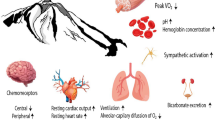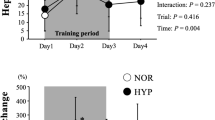Abstract
The aim of this study was to determine the response of blood markers to acute hypoxia in high-level endurance athletes before training based on “living high-training low” model. Thirty endurance athletes performed a hypoxic cycling test and spent 3 h at rest in a simulated altitude of 3,000 m. At the end of the hypoxic cycling test, the quantity of the natural antisense transcript of HIF-1α mRNA (aHIF) transcript increased significantly (+37%, P = 0.024). After 3-h exposure, at a simulated altitude of 3,000 m, the amount of HIF-1α mRNA increased significantly (+57%, P = 0.012). Moreover, a large inter-subject range was observed in response to the hypoxic cycling test and to the prolonged hypoxic exposure: −133%/+79% and −82%/+653% for HIF-1α mRNA, 69%/+324% and −76%/+229% for aHIF. This study shows a large inter-variability of blood markers in elite athletes in response to acute hypoxic exposure corroborating previous observations made in other populations.





Similar content being viewed by others
References
Bakay M, Zhao P, Chen J, Hoffman EP (2002) A web-accessible complete transcriptome of normal human and DMD muscle. Neuromuscul Disord 12:25–41. doi:10.1016/S0960-8966(02)00093-7
Brugniaux JV, Schmitt L, Robach P, Nicolet G, Fouillot JP, Moutereau S, Lasne F, Pialoux V, Saas P, Chorvot MC, Cornolo J, Olsen NV, Richalet JP (2006) Eighteen days of “living high, training low” stimulate erythropoiesis and enhance aerobic performance in elite middle-distance runners. J Appl Physiol 100:203–211. doi:10.1152/japplphysiol.00808.2005
Bunn HF, Poyton RO (1996) Oxygen sensing and molecular adaptation to hypoxia. Physiol Rev 76:839–885
Bunn HF, Gu J, Huang LE, Park JW, Zhu H (1998) Erythropoietin: a model system for studying oxygen-dependent gene regulation. J Exp Biol 201:1197–1201
Cayre A, Rossignol F, Clottes E, Penault-Llorca F (2003) aHIF but not HIF-1alpha transcript is a poor prognostic marker in human breast cancer. Breast Cancer Res 5:R223–R230. doi:10.1186/bcr652
Chapman RF, Stray-Gundersen J, Levine BD (1998) Individual variation in response to altitude training. J Appl Physiol 85:1448–1456
Cheung VG, Spielman RS (2002) The genetics of variation in gene expression. Nat Genet 32:522–525. doi:10.1038/ng1036
Clark SA, Aughey RJ, Gore CJ, Hahn AG, Townsend NE, Kinsman TA, Chow CM, McKenna MJ, Hawley JA (2004) Effects of live high, train low hypoxic exposure on lactate metabolism in trained humans. J Appl Physiol 96:517–525. doi:10.1152/japplphysiol.00799.2003
Ge RL, Witkowski S, Zhang Y, Alfrey C, Sivieri M, Karlsen T, Resaland GK, Harber M, Stray-Gundersen J, Levine BD (2002) Determinants of erythropoietin release in response to short-term hypobaric hypoxia. J Appl Physiol 92:2361–2367
Gore CJ, Hahn AG, Aughey RJ, Martin DT, Ashenden MJ, Clark SA, Garnham AP, Roberts AD, Slater GJ, McKenna MJ (2001) Live high:train low increases muscle buffer capacity and submaximal cycling efficiency. Acta Physiol Scand 173:275–286. doi:10.1046/j.1365-201X.2001.00906.x
Gustafsson T, Bodin K, Sylven C, Gordon A, Tyni-Lenne R, Jansson E (2001) Increased expression of VEGF following exercise training in patients with heart failure. Eur J Clin Invest 31:362–366. doi:10.1046/j.1365-2362.2001.00816.x
Jedlickova K, Stockton DW, Chen H, Stray-Gundersen J, Witkowski S, Ri-Li G, Jelinek J, Levine BD, Prchal JT (2003) Search for genetic determinants of individual variability of the erythropoietin response to high altitude. Blood Cells Mol Dis 31:175–182. doi:10.1016/S1079-9796(03)00153-0
Jewell UR, Kvietikova I, Scheid A, Bauer C, Wenger RH, Gassmann M (2001) Induction of HIF-1alpha in response to hypoxia is instantaneous. FASEB J 15:1312–1314
Levine BD, Stray-Gundersen J (1997) “Living high-training low”: effect of moderate-altitude acclimatization with low-altitude training on performance. J Appl Physiol 83:102–112
Mahoney DJ, Carey K, Fu MH, Snow R, Smith DC, Parise G, Tarnopolsky MA (2004) Real-time RT-PCR analysis of housekeeping genes in human skeletal muscle following acute exercise. Physiol Genomics 18:226–231. doi:10.1152/physiolgenomics.00067.2004
Maloney J, Wang D, Duncan T, Voelkel N, Ruoss S (2000) Plasma vascular endothelial growth factor in acute mountain sickness. Chest 118:47–52. doi:10.1378/chest.118.1.47
Maxwell PH (2004) HIF-1’s relationship to oxygen: simple yet sophisticated. Cell Cycle 3:156–159
Mounier R, Pialoux V, Cayre A, Schmitt L, Richalet JP, Robach P, Lasne F, Coudert J, Fellmann N, Clottes (2006) Leukocyte’s HIF-1 expression and training-induced erythropoietic response in swimmers. Med Sci Sports Exerc 38:1410–1417. doi:10.1249/01.mss.0000228955.98215.a1
Ollerenshaw M, Page T, Hammonds J, Demaine A (2004) Polymorphisms in the hypoxia inducible factor-1alpha gene (HIF1A) are associated with the renal cell carcinoma phenotype. Cancer Genet Cytogenet 153:122–126. doi:10.1016/j.cancergencyto.2004.01.014
Page EL, Robitaille GA, Pouyssegur J, Richard DE (2002) Induction of hypoxia-inducible factor-1α by transcriptional and translational mechanisms. J Biol Chem 277:48403–48409. doi:10.1074/jbc.M209114200
Ponsot E, Dufour SP, Zoll J, Doutrelau S, N’Guessan B, Geny B, Hoppeler H, Lampert E, Mettauer B, Ventura-Clapier R, Richard R (2006) Exercise training in normobaric hypoxia in endurance runners. II. Improvement of mitochondrial properties in skeletal muscle. J Appl Physiol 100:1249–1257. doi:10.1152/japplphysiol.00361.2005
Rathat C, Richalet JP, Herry JP, Larmignat P (1992) Detection of high-risk subjects for high altitude diseases. Int J Sports Med 13:S76–S78. doi:10.1055/s-2007-1024602
Robach P, Schmidt L, Brugniaux JV, Roels B, Millet G, Hellard P, Nicolet G, Duvallet A, Fouillot JP, Moutereau S, Lasne F, Pialoux V, Olsen NV, Richalet JP (2006) Living high–training low: effect on erythropoiesis and aerobic performance in highly-trained swimmers. Eur J Appl Physiol 97:695–705. doi:10.1007/s00421-006-0240-7
Roels B, Thomas C, Bentley DJ, Mercier J, Hayot M, Millet G (2007) Effects of intermittent hypoxic training on amino and fatty acid oxidative combustion in human permeabilized muscle fibers. J Appl Physiol 102:79–86. doi:10.1152/japplphysiol.01319.2005
Rossignol F, Vaché C, Clottes E (2002) Natural antisense transcripts of hypoxia-inducible factor 1alpha are detected in different normal and tumour human tissues. Gene 299:135–140. doi:10.1016/S0378-1119(02)01049-1
Saunders PU, Telford RD, Pyne DB, Cunningham RB, Gore CJ, Hahn AG, Hawley JA (2004) Improved running economy in elite runners after 20 days of simulated moderate-altitude exposure. J Appl Physiol 96:931–937. doi:10.1152/japplphysiol.00725.2003
Semenza GL (1999) Perspectives on oxygen sensing. Cell 98:281–284. doi:10.1016/S0092-8674(00)81957-1
Semenza GL (2003) Targeting HIF-1 for cancer therapy. Nat Rev Cancer 3:721–732. doi:10.1038/nrc1187
Stray-Gundersen J, Chapman RF, Levine BD (2001) “Living high-training low” altitude training improves sea level performance in male and female elite runners. J Appl Physiol 91:1113–1120
Thrash-Bingham CA, Tartof KD (1999) aHIF: a natural antisense transcript overexpressed in human renal cancer and during hypoxia. J Natl Cancer Inst 91:143–151. doi:10.1093/jnci/91.2.143
Uchida T, Rossignol F, Matthay MA, Mounier R, Couette S, Clottes E, Clerici C (2004) Prolonged hypoxia differentially regulates hypoxia-inducible factor (HIF)-1alpha and HIF-2alpha expression in lung epithelial cells: implication of natural antisense HIF-1alpha. J Biol Chem 279:14871–14878. doi:10.1074/jbc.M400461200
Vestergaard H, Andersen PH, Lund S, Schmitz O, Junker S, Pedersen O (1994) Pre- and post-translational upregulation of muscle-specific glycogen synthase in athletes. Am J Physiol 266:92–101
Vogt M, Puntschart A, Geiser J, Zuleger C, Billeter R, Hoppeler H (2001) Molecular adaptations in human skeletal muscle to endurance training under simulated hypoxic conditions. J Appl Physiol 91:173–182
Wittwer M, Billeter R, Hoppeler H, Fluck M (2004) Regulatory gene expression in skeletal muscle of highly endurance-trained humans. Acta Physiol Scand 180:217–227. doi:10.1046/j.0001-6772.2003.01242.x
Zeng SM, Yankowitz J, Widness JA, Strauss RG (2001) Etiology of differences in hematocrit between males and females: sequence-based polymorphisms in erythropoietin and its receptor. J Gend Specif Med 4:35–40
Zoll J, Ponsot E, Dufour SP, Doutrelau S, Ventura-Clapier R, Vogt M, Hoppeler H, Richard R, Fluck M (2006) Exercise training in normobaric hypoxia in endurance runners. III. Muscular adaptations of selected gene transcripts. J Appl Physiol 100:258–1266. doi:10.1152/japplphysiol.00936.2005
Acknowledgments
This study was funded by the “International Olympic Committee” and the “Ministère de la Jeunesse et des Sports”. The authors would like to thank the athletes for their donation of time and blood. We also thank Fabrice Kwiatkowski for statistics and Glen Foster for careful reading of the manuscript.
Author information
Authors and Affiliations
Corresponding author
Rights and permissions
About this article
Cite this article
Mounier, R., Pialoux, V., Schmitt, L. et al. Effects of acute hypoxia tests on blood markers in high-level endurance athletes. Eur J Appl Physiol 106, 713–720 (2009). https://doi.org/10.1007/s00421-009-1072-z
Accepted:
Published:
Issue Date:
DOI: https://doi.org/10.1007/s00421-009-1072-z




